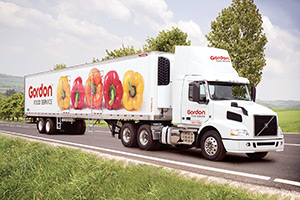Aftermarket Sales Growing; Fleets Keep Service In-House

This story appears in the Feb. 2 print edition of Transport Topics.
LAS VEGAS — Trucking parts sales are projected to continue growing, but shortcomings in service could limit additional aftermarket opportunities, industry officials said.
A record crowd of more than 300 exhibitors and 600 distributors meeting here Jan. 26-29 for the 10th annual Heavy Duty Aftermarket Week was noticeably upbeat about the year ahead. But they also heard fresh evidence of the continued reluctance among fleets to outsource service and potential challenges posed by the vertical-integration push by original equipment manufacturers.
“There are opportunities there, but they are not yet being met,” Stu MacKay, president of consulting and research firm MacKay and Co., said of the $50 billion service business.
MacKay said “operators want to outsource more,” but his company’s research found the quality of work performed, the cost of repairs and the added downtime were the top reasons they kept work in-house, rather than shifting to dealers or independent service garages.
He said of the estimated 495 million hours spent servicing trucks in 2011, the most recent data available, 75% was conducted by end users.
While part of that high percentage is due to savings on time or miles traveled, it also shows “they cannot find acceptable service suppliers,” MacKay said.
The point was underscored by Lori Coleman, corporate fleet manager of Gordon Food Service, No. 24 on the Transport Topics Top 100 list of the largest private fleets in North America.
She said the family-owned company conducts about 85% of all service work in-house. The exceptions, she said, tend to be engine warranty work and jobs requiring more than four hours.
“The quality is the lowest we’ve ever seen,” she said of the company’s recent experiences with dealers and independent garages. “When a truck comes back to us, we have to physically go over it and make sure it is correct.”
Coleman estimated between 60%-70% of the time a company technician will need to “refix” part of the work. She also lamented poor communication among repair shops, often requiring
follow-ups on the work and uncertainty regarding repair status.
Brian Mulshine, a longtime Navistar Inc. executive who recently joined truck dealer Rush Enterprises as director of operations technology and innovation, acknowledged a need to increase transparency and accuracy of repair expenses and times.
However, he also pointed out that fleets often don’t provide enough information to fix the problem. One large fleet, for example, has a porter drop off a vehicle without any real knowledge of the symptoms.
“It is important to get as much information from the driver as possible,” Mulshine said. “We can significantly reduce downtime by getting more information.”
Mike Delaney, president of truck repair chain WheelTime, recommended independent shops and fleets work together to set specific parameters ahead of a vehicle breaking down.
“The fastest decision is the one you make in advance,” he said.
During HDAW, some aftermarket officials said OEMs’ emphasis on vertical integration — using more of their own proprietary products — was a growing concern.
Likewise, Coleman said she viewed vertical integration as a “bad” thing.
“I want to choose what I will have on my trucks,” Coleman said.
She said Gordon is unable to spec the lighting package it wants, and that it can be frustrating when “some purchasing guys” at OEMs make decisions without understanding the real-life implications.
She added that the captive OEM powertrain she was using was limiting service choices when it came to warranty work, resulting, in her opinion, in greater downtime.
The tendency of OEMs to guard engine repair codes — combined with the increasing sophistication of the engines themselves — had some here concerned about the ability of independent shops to compete.
WheelTime’s Delaney countered more computerized engines actually could simplify matters for shops.
“As things get more integrated and electronic, we will get more guidance from the units themselves on how to diagnose and fix them,” he said.
Delaney noted that 85% of the time a truck is in a shop it is for reasons other than the actual service, such as waiting on warranty approval or required parts.
Better access to remote diagnostics systems should cut into that percentage and provide fleets with a better experience, he said.
That sentiment was shared during a separate discussion that included Bill Kozek, Navistar International Corp.’s president of truck and parts. He said systems such as the company’s OnCommand Connection will help direct trucks to a location where a required part is in stock.
As for the overall truck-and-trailer parts market, it grew about 2% last year to more than $26 billion, said John Blodgett, vice president of sales and marketing for MacKay.
Slow but steady growth to more than $32 billion is expected through the rest of the decade, he said.

